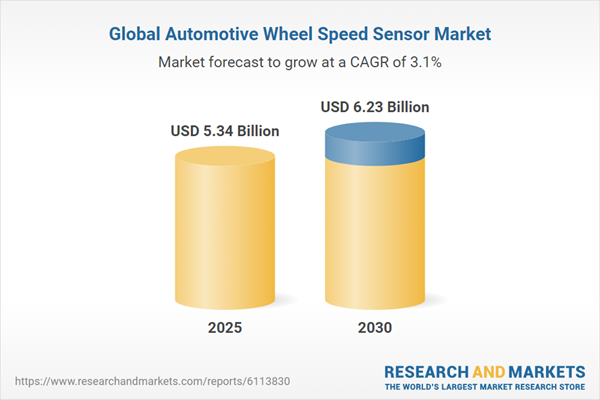The global automotive wheel speed sensor market is experiencing significant growth driven by the widespread adoption of anti-lock braking systems (ABS), stringent government regulations mandating minimum stopping distances, and rising automotive sales worldwide. The market’s expansion is particularly pronounced in developing countries in the Asia-Pacific region, where increased vehicle production and sales are fueling demand. However, the high cost of ABS-equipped vehicles, driven by expensive electronic components and technology, remains a key restraint on market growth compared to traditional braking systems.
Market Segmentation Analysis
By Sensor Type
The market is divided into active and passive wheel speed sensors. Active sensors dominate due to their use of the Hall effect principle, offering true zero-speed capability and precise switch-point measurement, enabling accurate wheel movement detection even when vehicles are stationary. Passive sensors, while simpler in construction, are projected to grow steadily, supported by advancements in magnetic-type sensors that enhance operational accuracy.By Vehicle Type
The market segments include passenger vehicles, light commercial vehicles, and heavy commercial vehicles. Passenger vehicles hold the largest share, propelled by rising sales, increasing disposable incomes, and mandatory ABS integration in many regions. This segment’s dominance reflects the broader trend of prioritizing safety features in consumer vehicles.By Geography
Geographically, the market is segmented into North America, South America, Europe, Middle East & Africa, and Asia-Pacific. Asia-Pacific leads as the largest and most dominant market, driven by robust government support for the automotive industry, rapid industrialization, and a focus on developing innovative products to meet evolving consumer demands. The region’s emphasis on technological advancements and automotive production significantly contributes to market growth.Key Product Offerings
Bosch Wheel-Speed Sensor
Bosch’s wheel-speed sensors utilize a non-contact measurement approach, integrating a Hall-sensing element, signal amplifier, and signal processing on a single chip. These sensors detect wheel speed via a fluctuating magnetic field from a revolving encoder, which may be a multipole or metal wheel, with a magnet required for steel wheel applications. Designed for compatibility with highly automated driving, Bosch sensors offer signal redundancy and multiple variations to meet diverse needs.Continental Wheel Speed Sensor (WSS)
Continental’s WSS leverages anisotropic magnetoresistance effects (AMR or GMR) to measure wheel speed, enabling communication with control systems like ABS, traction control (TCS), and electronic stability control (ESC). With integrated signal processing, these sensors perform a wide range of tasks, boasting a robust design, adjustable reading positions, and compliance with ISO 26262 safety standards. Their streamlined development process minimizes layout variations and validation efforts.Conclusion
The automotive wheel speed sensor market is poised for continued growth, driven by ABS adoption, regulatory mandates, and regional automotive industry advancements, particularly in Asia-Pacific. While active sensors and passenger vehicles lead their respective segments, innovations in sensor technology and safety compliance are shaping a competitive and dynamic market landscape. High costs remain a challenge, but ongoing developments aim to balance affordability and performance.Key Benefits of this Report:
- Insightful Analysis: Gain detailed market insights covering major as well as emerging geographical regions, focusing on customer segments, government policies and socio-economic factors, consumer preferences, industry verticals, and other sub-segments.
- Competitive Landscape: Understand the strategic maneuvers employed by key players globally to understand possible market penetration with the correct strategy.
- Market Drivers & Future Trends: Explore the dynamic factors and pivotal market trends and how they will shape future market developments.
- Actionable Recommendations: Utilize the insights to exercise strategic decisions to uncover new business streams and revenues in a dynamic environment.
- Caters to a Wide Audience: Beneficial and cost-effective for startups, research institutions, consultants, SMEs, and large enterprises.
What do businesses use our reports for?
Industry and Market Insights, Opportunity Assessment, Product Demand Forecasting, Market Entry Strategy, Geographical Expansion, Capital Investment Decisions, Regulatory Framework & Implications, New Product Development, Competitive IntelligenceReport Coverage:
- Historical data from 2022 to 2024 & forecast data from 2025 to 2030
- Growth Opportunities, Challenges, Supply Chain Outlook, Regulatory Framework, and Trend Analysis
- Competitive Positioning, Strategies, and Market Share Analysis
- Revenue Growth and Forecast Assessment of segments and regions including countries
- Company Profiling (Strategies, Products, Financial Information, and Key Developments among others).
Segmentation
By Sensor Type
- Active
- Passive
By Vehicle Type
- Passenger Vehicle
- Light Commercial Vehicle
- Heavy Commercial Vehicle
By Application
- Anti-lock Braking System
- Electronic Stability Control
- Tire Pressure Monitoring System
- Others
By Geography
- North America
- United States
- Canada
- Mexico
- South America
- Brazil
- Argentina
- Others
- Europe
- Germany
- France
- United Kingdom
- Spain
- Others
- Middle East and Africa
- Israel
- Saudi Arabia
- UAE
- Others
- Asia Pacific
- China
- Japan
- South Korea
- India
- Taiwan
- Thailand
- Indonesia
- Others
Table of Contents
Companies Mentioned
- Continental AG
- Denso Corporation
- Forvia Group
- Robert Bosch GmbH
- KA Sensors Ltd
- Honeywell International Inc.
- SMP Europe
- Astemo, Ltd.
- ZF Friedrichshafen AG
- RACELOGIC
- TE Connectivity
- Infineon Technologies AG
- Valeo
Table Information
| Report Attribute | Details |
|---|---|
| No. of Pages | 144 |
| Published | June 2025 |
| Forecast Period | 2025 - 2030 |
| Estimated Market Value ( USD | $ 5.34 Billion |
| Forecasted Market Value ( USD | $ 6.23 Billion |
| Compound Annual Growth Rate | 3.1% |
| Regions Covered | Global |
| No. of Companies Mentioned | 13 |









